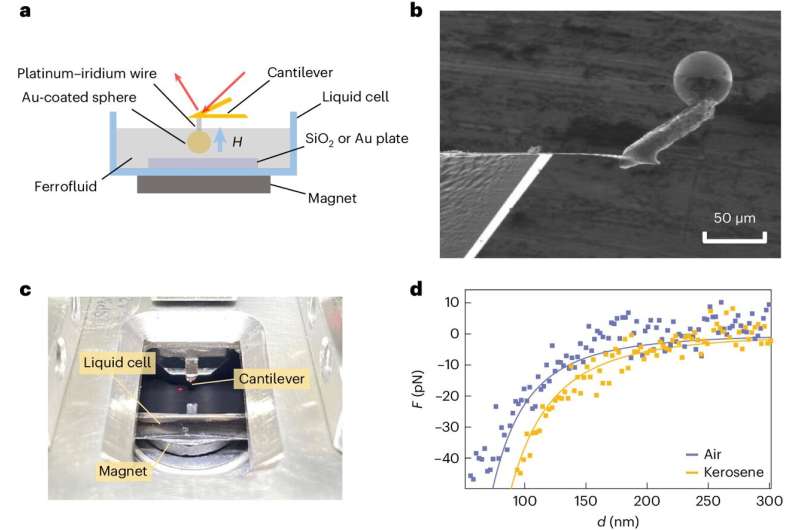

Artist’s impression of a photonic Bose-Einstein condensate (yellow) in a bath of dye molecules (red) that has been stirred by an external light source (white flash). Credit: A. Erglis/Albert-Ludwigs University of Freiburg
Researchers at the University of Bonn have demonstrated that super photons, or the photo Bose-Einstein condensates conform to the fundamental theorems of physics, enabling insights into properties that are often difficult to observe.
Under the right conditions, thousands of light particles can coalesce into a type of “super photon”. Physicists call such a state a photon Bose-Einstein condensate. Researchers at the University of Bonn have now shown that this exotic quantum state obeys a fundamental theorem of physics. This discovery now enables the measurement of properties of Bose-Einstein photon condensates, which are usually difficult to access. The study was published June 3 in the journal Nature Communications.
If many atoms are cooled to a very low temperature confined to a small volume, they can become indistinguishable and behave as a single “superparticle”. Physicists also call this a Bose-Einstein condensate or quantum gas. Photons are condensed based on a similar principle and can be cooled using dye molecules. These molecules act like little refrigerators and swallow “hot” light particles before spitting them back out at the right temperature.
Experimenting with super photons in quantum gases
“In our experiments we filled a small container with a dye solution,” explains Dr. Julian Schmitt from the Institute of Applied Physics at the University of Bonn. “The walls of the container were very reflective.” The researchers then excited the dye molecules with a laser. This produced photons that bounced back and forth between the reflective surfaces. As the light particles repeatedly collided with the dye molecules, they cooled and eventually condensed into a quantum gas.
This process continues afterwards, however, and the super photon particles repeatedly collide with the dye molecules, being swallowed before being spat out again. Therefore, the quantum gas sometimes contains more and sometimes fewer photons, causing it to flicker like a candle. “We used this vibration to investigate whether an important theorem of physics is valid in a quantum gas system,” says Schmitt.
Understanding the regression theorem in quantum gases
This so-called “regression theorem” can be illustrated with a simple analogy: Let’s suppose that the super photon is a campfire that sometimes accidentally lights up very brightly. After the fire burns particularly strongly, the flames slowly die down and the fire returns to its original state. Interestingly, one can deliberately cause a fire to start by blowing air into the embers. In simple terms, the regression theorem predicts that the fire will continue to burn in the same way as if the ignition had occurred by chance. This means that it responds to disturbance in the same way as it fluctuates on its own without any disturbance.
Blowing air into a photon fire
“We wanted to find out if this behavior also applies to quantum gases,” explains Schmitt, who is also a member of the interdisciplinary research area (TRA) Building Blocks of Matter and the group Matter and Light for Quantum Computing. Excellence at the University of Bonn. To this end, the researchers first measured the vibration of the super photons to quantify the statistical fluctuations. They then – figuratively speaking – threw air on the fire by briefly firing another laser at the super photon. This disturbance caused him to light up briefly before slowly returning to his original state.
Demonstration of nonlinear behavior in quantum systems
“We were able to observe that the response to this mild perturbation follows exactly the same dynamics as random fluctuations without a perturbation,” says the physicist. “In this way we were able to demonstrate for the first time that this theorem also holds for exotic forms of matter such as quantum gases.” Interestingly, this is also the case for strong concerns. Systems usually react differently to stronger disturbances than to weaker ones – an extreme example is an ice sheet that will break suddenly when the load placed on it becomes too heavy. “This is called nonlinear behavior,” says Schmitt. “However, the theorem remains valid in these cases, as we have now been able to demonstrate together with our colleagues from the University of Antwerp.”
Implications for research in photonic quantum gases
The findings are of great importance for fundamental research with quantum photonic gases, because it is often not known exactly how they will vibrate in their brightness. It is much easier to determine how the superphoton responds to a controlled perturbation. “This allows us to learn about unknown properties under very controlled conditions,” explains Schmitt. “It will enable us, for example, to discover how new photonic materials consisting of many super photons behave at their core.”
Reference: “Observation of Nonlinear Response and Onsager Regression in a Photon Bose-Einstein Condensate” by Alexander Sazhin, Vladimir N. Gladilin, Andris Erglis, Göran Hellmann, Frank Vewinger, Martin Weitz, Michiel Wouters, and Julian Schmitt, 3 June 2024, Nature Communications.
DOI: 10.1038/s41467-024-49064-9
The Institute of Applied Physics at the University of Bonn, the University of Antwerp (Belgium) and the University of Freiburg participated in the study. The project was supported by the German Research Foundation (DFG), the European Union (ERC Starting Grant), the German Aerospace Center (DLR) and the Belgian funding agency FWO Flanders.
#Quantum #Magic #Super #Photons #shaping #future #physics
Image Source : scitechdaily.com




